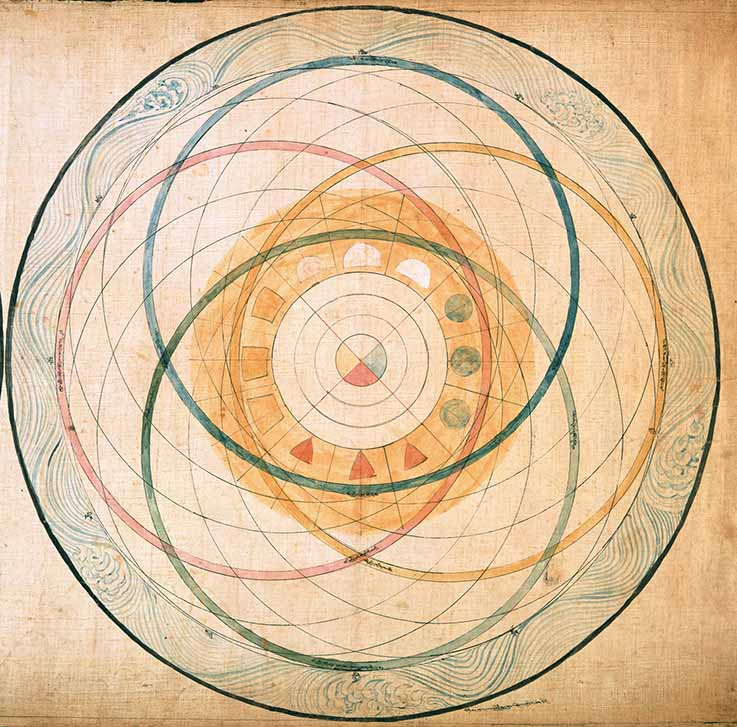ALL LIFE ON earth is governed by the courses of the heavenly bodies, especially by the sun and the moon. They are responsible for the rhythm of time and for fluctuations in the earth’s climate and hence have an immediate impact on our existence. For thousands of years mankind has looked up at the sky and sought to explain these heavenly bodies as elements of a coherent system. Museum Rietberg is currently hosting an exhibition, which explores cosmologies, cosmogonies and creation myths conceived by people in different cultures and periods of history.
For our ancestors, the laws of the cosmos provided reliable measures that allowed them to orient themselves in time and space. The celestial bodies determined human existence through the rhythm of days, months, seasons and years. The course of the sun and the stars showed that the earthly sphere was aligned in a certain direction. Not only could the points of the compass be used for orientation, they also inspired people to build stone monuments, graves, temples and even whole cities based on these cosmic constants.
The Pole Star and Cosmologies
The Pole star, around which the other stars appeared to revolve, or the midday sun were regarded as fixed points in a cosmic axis over which the firmament stretched like a celestial canopy and which some cultures imagined as a Tree of Life, or a world mountain. The heavens were imbued with a force, they patently determined human fate and controlled the changing seasons and the forces of nature.
Finite existence beneath the firmament of the eternal order caused humans to ponder the origin of heaven and earth, to ask questions about the who, the whence and whither of existence and about the apparently supernatural forces that once provided the impulse for the creation of the world and the universe.
Creation Myths from 17 Different Countries
This exhibition shows human conceptions of the cosmos since time immemorial using examples from 17 different cultures from around the world. It shows how these civilisations have investigated the world around them and what kinds of creation myths they have thought up to explain its origins. In some cases the focus is more on myths, in others on the cosmologies, the exploration and observation of space.
The cosmologies based on ancient scientific methods are particularly intriguing, showing for example the ideas about time and space held by Indian religions. The early Buddhist theories about the cosmos are based on the assumption that the number of world systems is infinite and that these world systems are not arranged spherically in space but instead in a ribbon-like form: a kind of galaxy, in other words.
These ideas shared with modern cosmology the belief that the world was subject to constant change rather than being a stable structure that always remained the same. The time periods over which the universe evolved, of decay and rebirth, are of course enormous. Hinduism has similar conceptions of time such as the theory of the four ages of the worlds. According to this idea, a cycle of emergence and dissolution takes 40 billion years.
The Age of Our Universe and Cosmologies
The age of our universe – 13.8 billion years according to modern cosmology – seems rather modest by comparison. Just as astounding are the accuracy of the ancient Greeks’ ideas about the cosmos and their skill in making cosmological calculations – knowledge that became largely lost in mediaeval Europe – or the precision with which Chinese astronomers were able to predict cosmic events such as the appearance of the comets.
Even more varied than the cosmologies are the creation myths that have been handed down to us. Whereas in Christianity the account of Creation as we know it from the biblical Book of Genesis came to prevail, Hinduism, for example, has a wide range of myths, each telling a different story covering a different aspect of creation. How did everything begin? This central question that forms the starting point for all creation myths is answered in very many different ways: some myths simply leave it unanswered, others feature a creator or a kind of cosmic master-builder, while others still assume a process of growth and decay in perpetual motion, which requires neither a Creator nor a Destroyer.
The Idea of the Cosmos
While the idea that the cosmos may have evolved out of nothing does exist, most cultures presuppose the existence of a divine. In Buddhist creation myths the world consists mainly of water. In order to create the world, Chaos was untangled or primeval matter separated into its constituent parts and distributed, as described by the ancient Chinese idea of the evolution of Yin and Yang. Life may be breathed into the world via fragmentation and destruction.
Thanks to the latest research we know an extraordinary amount and the horizons of our knowledge are broadening all the time. But ultimately we are still a long way from really understanding the cosmos. Viewed like this, it certainly makes sense to look at earlier cosmological notions, for these likewise contain half-truths even if they are different to the rational and empirical explanations offered by the modern world. And they illustrate how ingenious humans have been in trying to unravel the mysteries of the cosmos.
Until 31 May 2015, at Museum Rietberg, Gablerstrasse 15, Zurich CH-8002, www.rietberg.ch





